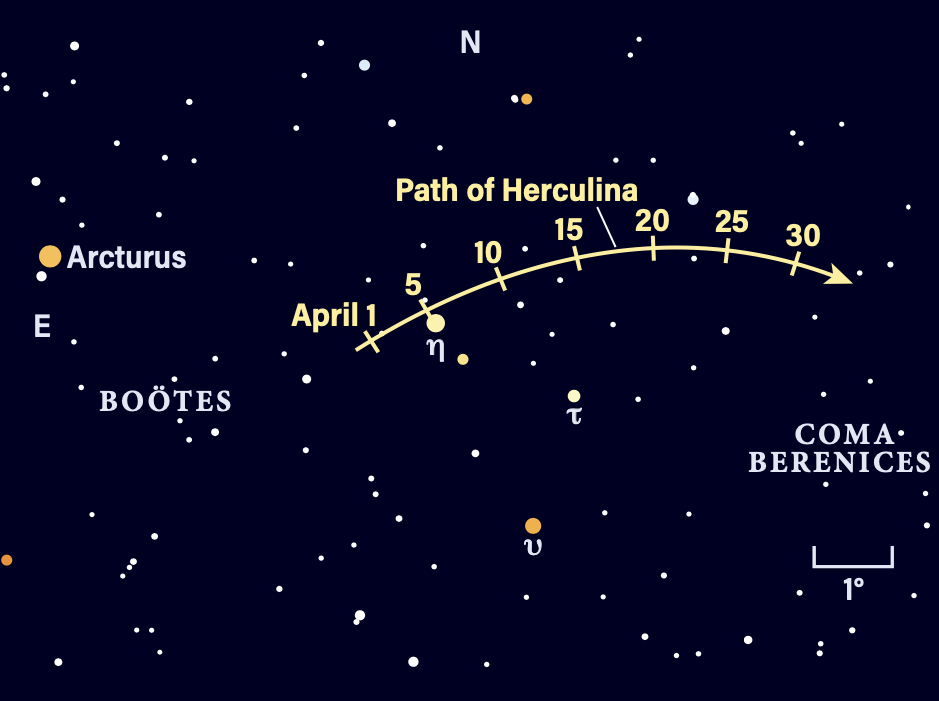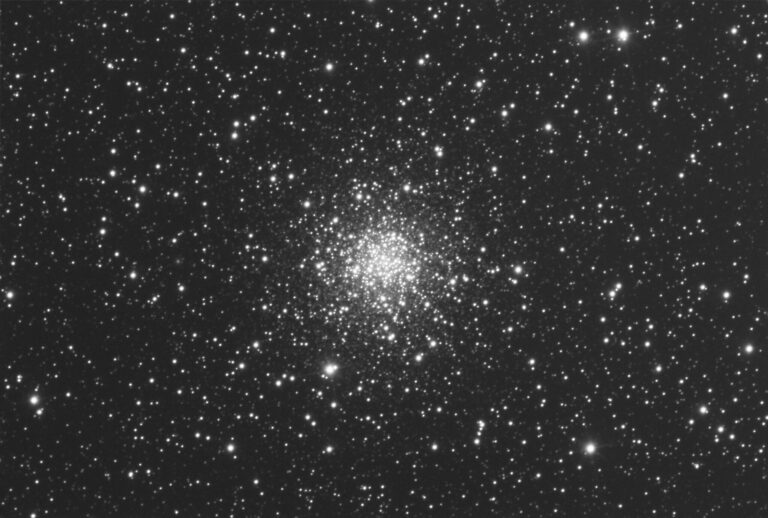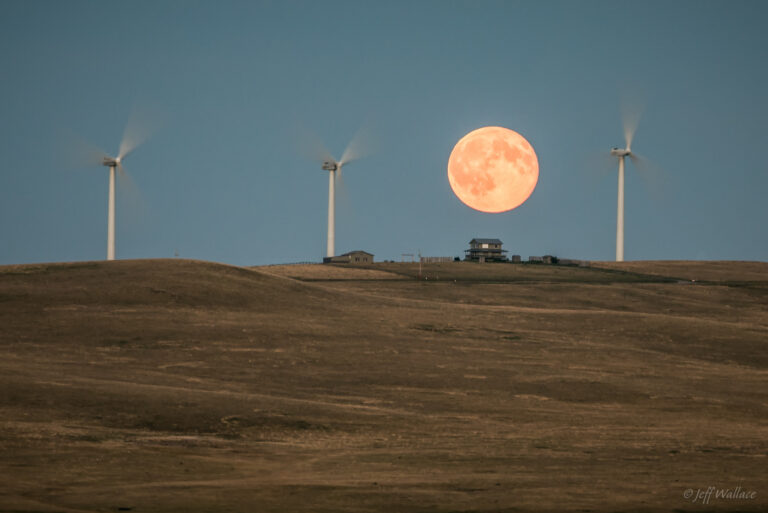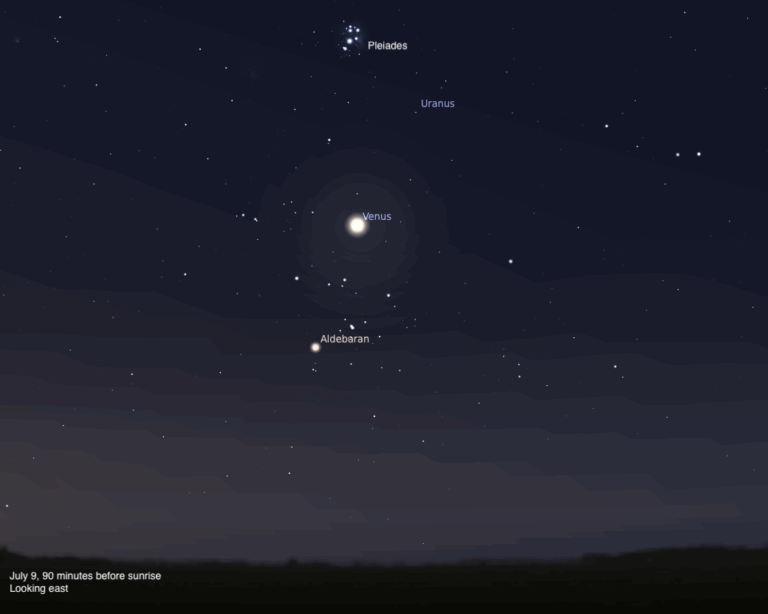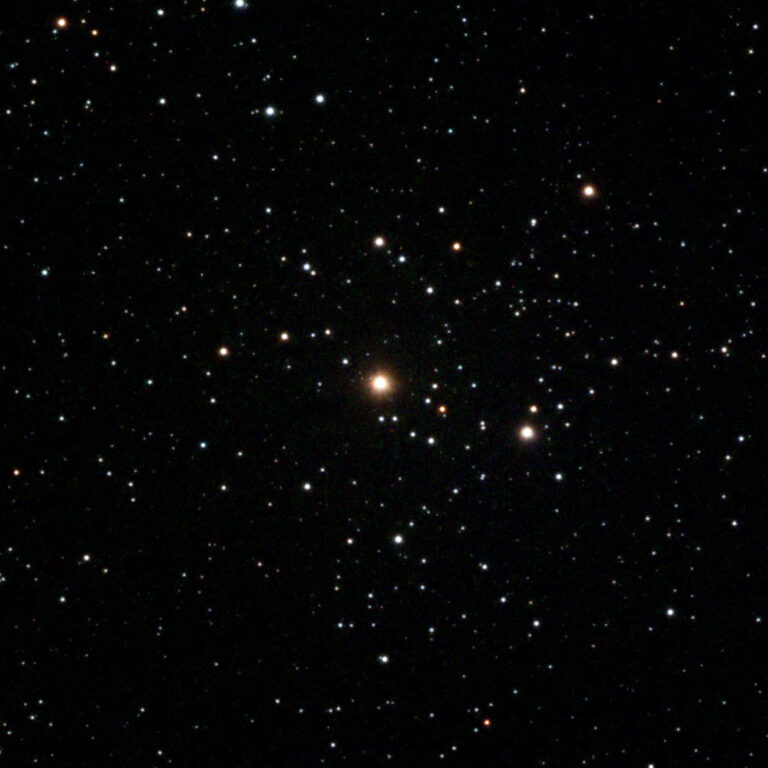
Key Takeaways:
It’s here at last! The April 8 total eclipse of the Sun is visible from a narrow track spanning North America from southwest to northeast. While the majority of people across the U.S. will see a partial eclipse of varying degrees, millions will travel to be in that special location inside totality for the spectacle of seeing the corona surrounding the intensely black disk of the Moon as it covers the Sun, an apparent hole in the sky. So sudden is the drop in light during the last 30 seconds leading up to the event — an effect missed from all the partial zones — that totality observers often shout in joy and delight. While a partial eclipse is nice, a total one is the epitome of awe.
In addition to this spectacle, there’s an array of planets visible all month, as Jupiter and Uranus lie close together in a conjunction, with Comet 12P/Pons-Brooks located a few degrees from the pair. Venus is sliding behind the Sun, but Saturn and Mars grow in visibility in the pre-dawn sky. They are joined by Mercury, which switches from east to west of the Sun during the month.
We’ll start with the total eclipse April 8. It’s the second total eclipse in seven years for the U.S., but the next one to cross the contiguous U.S. isn’t until 2045. (Of course, there are total eclipses in other parts of the world during this period, including one that touches just three states in 2044.) Inside the track of totality, observers get the rare and enchanting view of the corona, and with the recent increase in solar activity its appearance will be very different to that observed in 2017.
The track of totality makes landfall on the Mexican Pacific coast at Mazatlán, where totality lasts 4 minutes 17 seconds. The longest duration of totality, lasting 4 minutes 28 seconds, occurs inland near Nazas, Durango, in Mexico at 1:17 p.m. MCDT. Ten minutes later, the shadow crosses the U.S. border near Eagle Pass, Texas, and heads toward Dallas-Fort Worth. The local population southeast of these cities (which host some 7 million people) will experience 4 minutes 23 seconds of totality starting at 1:40 p.m. CDT.
The eclipse track proceeds northeast at about 1,600 mph, crossing Oklahoma, Arkansas, Missouri, and into southern Illinois. There it passes over Carbondale, where the August 2017 eclipse was also visible.
The track passes over Indianapolis, where totality begins at 3:06 p.m. EDT, then Cleveland, where totality starts at 3:13 p.m. EDT. After crossing Lake Erie (missing Toronto by a few miles), the shadow of totality reaches Buffalo and Rochester in New York at 3:18 p.m. and 3:20 p.m. EDT, respectively, then crosses Lake Ontario. It reaches the final large city in its path, Montreal, at 3:26 p.m. EDT, before leaving Canada at Newfoundland and Labrador.
During the total phase of the eclipse, spend a moment looking for planets that will be visible. Most obvious is Venus, 15° southwest of the Sun. The next brightest planet, Jupiter, lies nearly 30° northeast of the Sun and should be easy to spot. Mars and Saturn will be more difficult, shining at magnitude 1.2 and 1, respectively, located about 35° southwest of the eclipsed Sun. Now turn back to the corona, because that’s what you traveled to see.
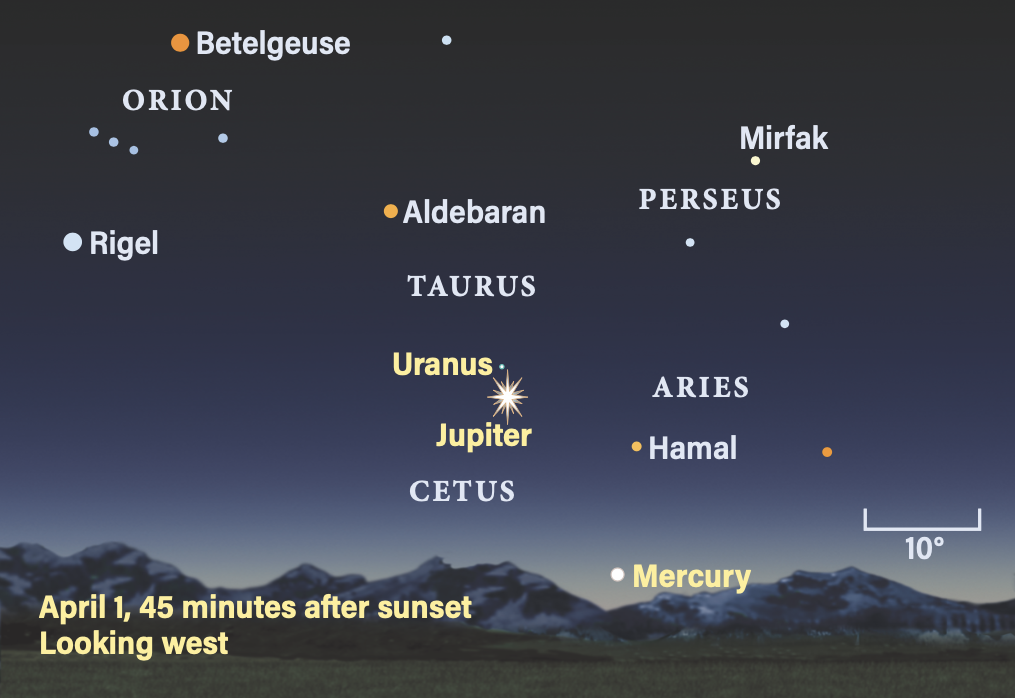
Mercury is fading in brighter evening twilight after last month’s eastern elongation. Catch it in the first couple of days of April. It shines at magnitude 1.3 on April 1 and magnitude 1.6 on April 2. It stands 5° high 45 minutes after sunset on April 1, and 1° lower on the 2nd. Over the next few days, the already tough target fades and sinks too low to pick up. Anyone living at higher altitude with little or no horizon haze might follow it through April 3.
Mercury reaches inferior conjunction with the Sun on April 11 and then quickly springs into the morning sky. It rises about 30 minutes before the Sun on April 20, but is too faint to see. By April 30, it is 3° high half an hour before sunrise and has brightened to magnitude 1.1.
Jupiter stands about 20° above the western horizon 45 minutes after sunset in early April, offering a narrow window for observation. This altitude drops to 2° at the same time by the end of the month, so the window is closing fast. It’s best in the first week of April; after that it’s more challenging, depending on your local obstructions.
However, there’s a fine conjunction to watch for as Jupiter finally passes Uranus on the 20th. An added attraction is the appearance of Comet 12P/Pons-Brooks in the same area of sky, although it may be too faint to see in binoculars due to the twilight. Pons-Brooks, discovered in 1812, reaches perihelion April 21.
The evening drama begins April 10, when a slender crescent Moon stands in the deepening twilight not far from the Pleiades (M45). Jupiter lies 4° below the Moon and glows brilliantly at magnitude –2. Grab binoculars to spy Uranus in the same field of view, located 1.8° above Jupiter and shining at magnitude 5.9.
Comet Pons-Brooks lies 4° due west of Jupiter — scan the area with binoculars starting about 50 minutes after sunset. You’ll have about 45 minutes more to spot the comet before its declining altitude in a darker sky competes with increasing horizon haze. If we’re extraordinarily lucky, the comet will produce another outburst and become a naked-eye object from dark locations. Whatever happens, the scene will present a fine photographic composition.
Pons-Brooks heads southeast and stands 4.5° due south of Jupiter by April 16 and crosses into western Taurus on the 19th. The comet is very close to the 4th-magnitude star Xi (ξ) Tauri on the 20th, though it’s becoming a difficult object in twilight.

The four bright Galilean moons, Io, Europa, Ganymede, and Callisto, orbit Jupiter with periods ranging from nearly two to 17 days. Despite the limited observing window this month, one event involving Ganymede is a good target for the Pacific time zone of the U.S.
Ganymede transits the planet’s south polar region April 8 beginning about 8:51 p.m. PST. Jupiter is less than 15° high, so you’ll need a clear western view to catch the beginning of the transit. Jupiter sets while the transit is underway.

The main planetary action is in the morning as Mars and Saturn grow in visibility, visited by a crescent Moon early on.
Forty minutes before sunrise on April 1, Mars and Saturn sit 6° and 3° above the eastern horizon, respectively. They’re 6° apart. Saturn is fractionally brighter at magnitude 1, with Mars 0.2 magnitude fainter.
By April 5, the two planets are only 3.5° apart. A waning crescent Moon joins the pair, 10.5° southwest of Mars. High above stands the Summer Triangle. On April 6, the thinner crescent 27-day-old Moon lies 2° southeast of Saturn.
The ringed planet and the Red Planet continue to close in, with the actual conjunction occurring late on the 10th. Earlier that morning, U.S. observers will see Mars 30′ northwest of Saturn. The pair stands 5° high 45 minutes before sunrise.
The following morning, April 11, Mars stands 35′ north-northeast of Saturn. Catch the planets soon after they rise (around 5:15 a.m. local time). Starting around 6 a.m., you should have a nice view if your eastern horizon is clear.
Through a telescope Saturn dominates the scene, with a 16″-wide planetary disk and rings extending about 36″ from end to end. The rings’ tilt is a slight 4°, with much of the southern half of the planet now visible. Mars shows a tiny disk 5″ across.
The visibility of Mars doesn’t improve much as the month progresses. By April 30 the planet stands 6° high in the eastern sky an hour before sunrise. On that date, Saturn is 13° southwest of Mars and already 11° high at the same time.
Neptune passed solar conjunction with the Sun last month and remains difficult due to morning twilight. By the end of the month it is 6° high in the east an hour before sunrise and 1° west of Mars.
Venus is approaching superior conjunction with the Sun in early June. With a clear eastern horizon you might spot it soon after it rises some 30 minutes before the Sun early in the month, shining at magnitude –3.9.

Rising Moon: Breaking down
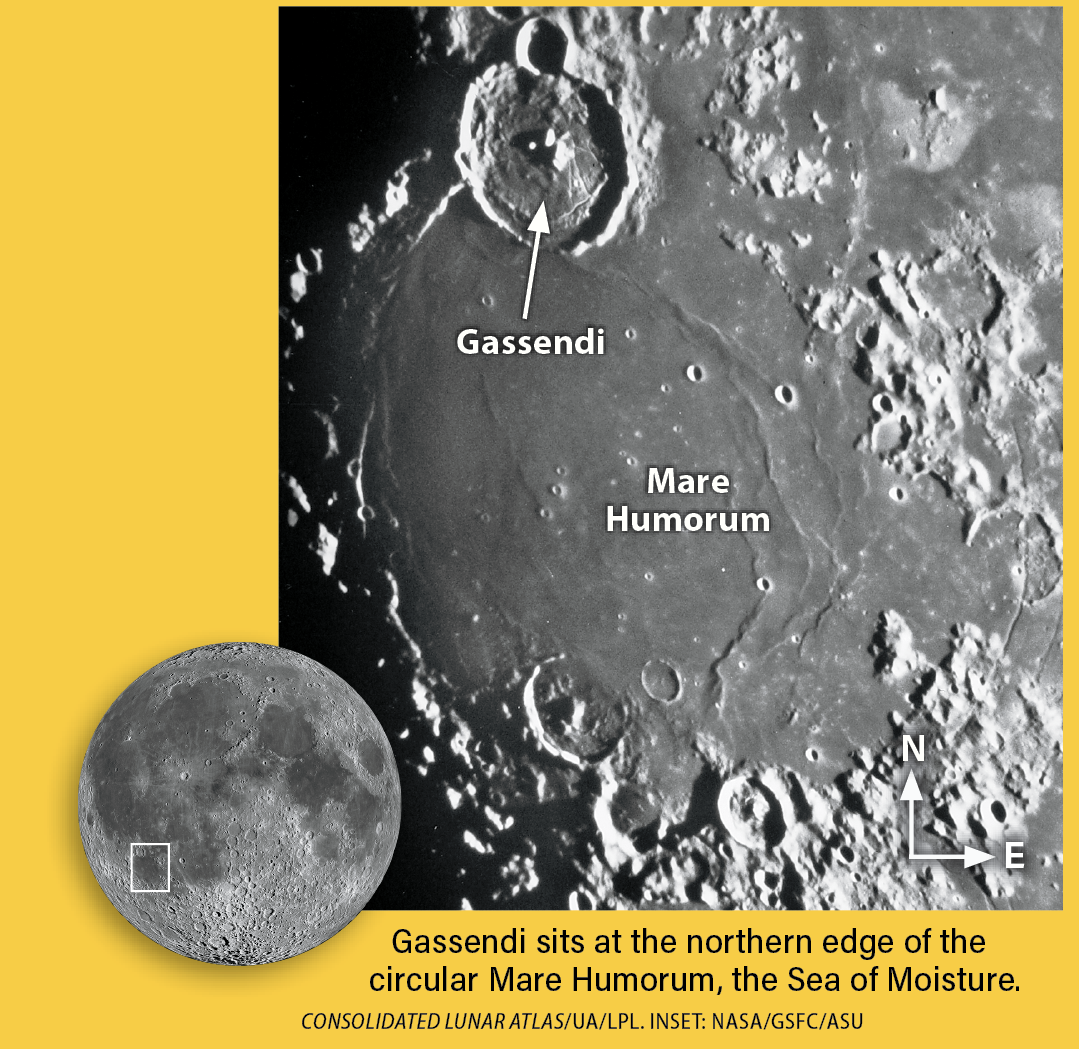
The waxing gibbous Moon is chock-full of interesting sights. You can even start your observing session before dark, when the light blue sky reduces glare. Take in Tycho’s long rays as well as the large expanse of Mare Imbrium and eye-catching Sinus Iridum on its northwestern portion. Then follow that up with the prominent crater Copernicus’ splatter.
At night the Moon is remarkably bright in a scope. A filter is best to cut down the light, though reducing the aperture with a mask or wearing sunglasses can help a lot, too.
On the evening of the 19th, a few days before Full, the sunrise line has moved past the fascinating crater Gassendi, perched on the north edge of the modest Mare Humorum in the lunar southwest. Formed by an impact event, Gassendi is a 70-mile-wide circular feature tilted down toward the center of the Sea of Moisture. The slumping of the lava-filled basin dragged the surrounding terrain down with it.
Gassendi has multiple peaks and slumped walls, characteristics of large craters. You can even see how the prominent crater on its north side formed afterward and pushed this material inward. The arcs and rilles inside the main ring to the south and southeast are leftovers of floor fracturing, where the up-and-down movement of the crust caused cracks like those you might find on a pie crust. Lava welled up from underneath, covering half the floor — though not as deep as the fully coated crater Plato far to the north.
A contemporary of Galileo and Kepler, Pierre Gassendi of France was a supporter of Copernicus’ heliocentric theory.
Meteor Watch: Only the brightest prevail
The annual Lyrid meteors are strongly affected by a Full Moon this month and not very favorable. Active from April 14–30, the shower peaks on the night of April 22, just one day before Full Moon. The Moon’s light causes enough of a glow to block out fainter meteors, leaving only a handful of bright ones visible. The radiant rises in late evening and stands about 30° high at local midnight. With the Moon in Virgo and visible all night, the typical zenithal hourly rate of 18 meteors per hour will likely be reduced to half a dozen per hour at most.
Like most meteor showers, the best time for the Lyrids is in the pre-dawn hours, when Lyra and Hercules stand high in the sky.
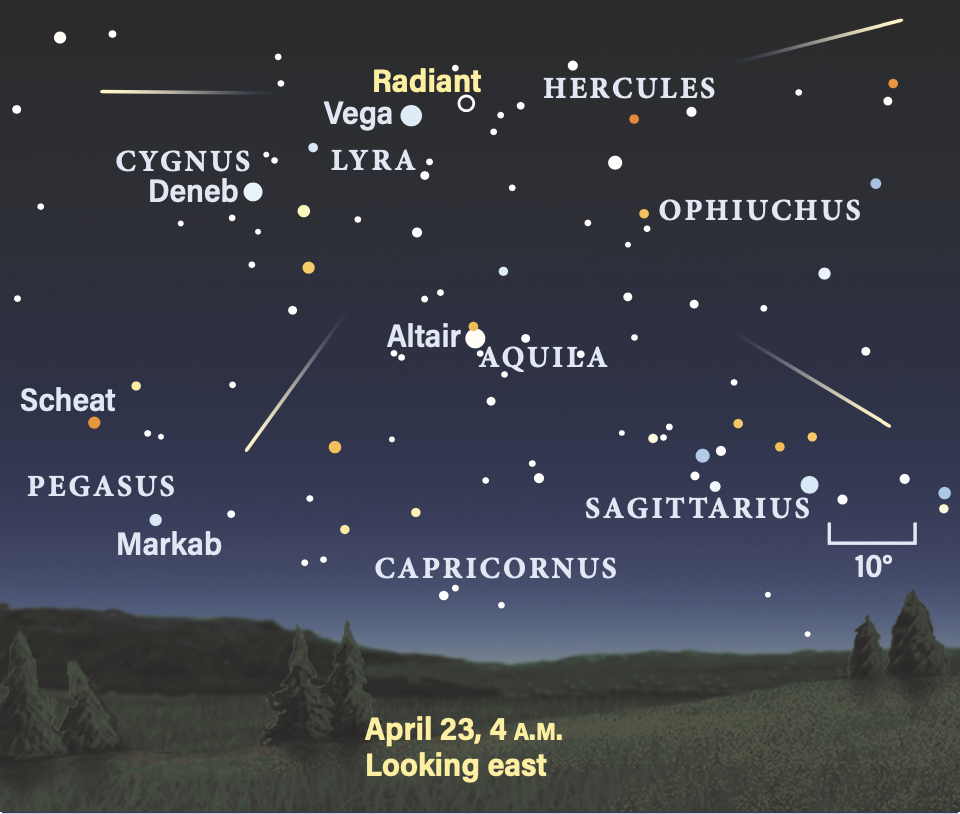
Comet Search: Spring serenity or surprise?
Save the evening of the 10th for cometary charm. Start observing 50 minutes after sunset to experience the full range of twilight colors, contrasts on the crescent Moon, blazing Jupiter and dim Uranus, and the dusty sword of 12P/Pons-Brooks, with the sparkling Pleiades (M45) floating above the whole scene.
Maximize your encounter by moving west of any big city to avoid looking through its veil of light pollution. Predicted to be 4th magnitude, Pons-Brooks is unlikely to be the lightsaber-like spectacle carried by newsfeeds. Yet the straight ion tail, carried by charged solar particles, might be long enough to thread the gap between the Moon and Jupiter. Binoculars are best, but a very low-power wide-field scope will also deliver. Remember to boost the power to check out the core; you just might see some green.
The comet has already had at least three outbursts at the time of this writing, so take a quick look every evening — and during the total solar eclipse, when it still sits near Jupiter — in case it erupts anew. Hit the observing hard in the first two weeks of the month. Afterwards, Pons-Brooks gets swallowed by twilight. South of the equator it remains a nice sight.
Need more comets? C/2021 S3 (PanSTARRS) glows at 7th magnitude, sailing the heart of the Cygnus Star Cloud overnight, only 2.5° from Albireo on the 6th. It should be turning green for imagers.
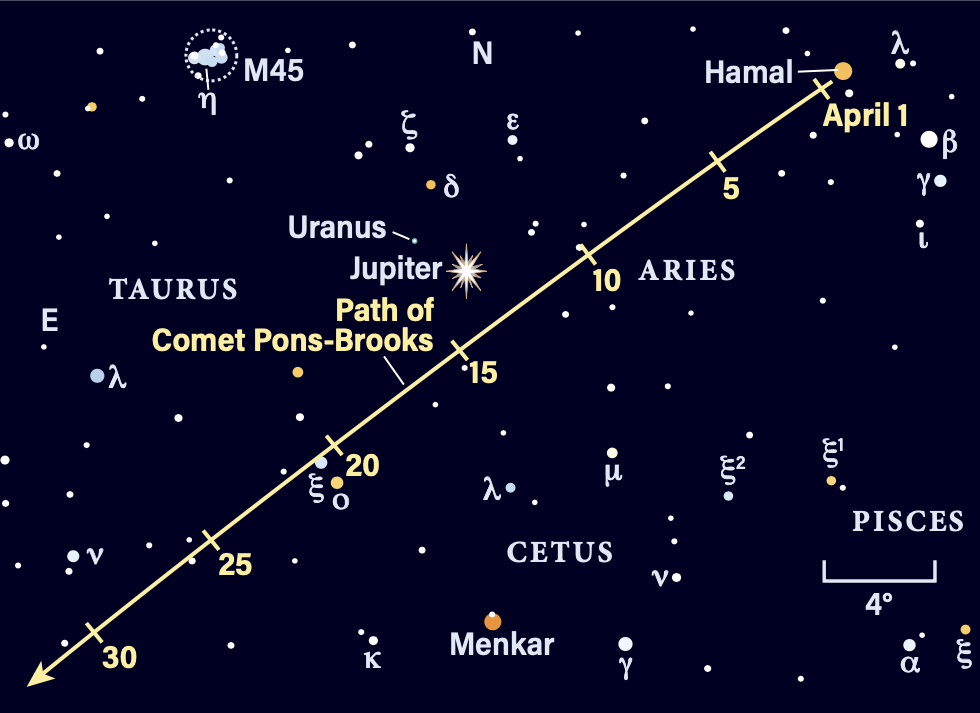
Locating Asteroids: Arc to Arcturus and hop to Herculina
A 60mm scope from the suburbs is all you’ll need to pick up 532 Herculina at 9th magnitude. Simply start at Arcturus, fourth-brightest star in the sky, then center on magnitude 2.7 Eta (η) Boötis, to Arcturus’ west-southwest. During the first week of the month Herculina will be in the same field! Grant yourself a four-hour session on the 5th and you will see the space rock shift against two brighter stars to turn a crooked line straight.
From the 15th through the 17th, this main-belt asteroid is the brightest object in the field. Somewhat potato-shaped and spanning about 100 miles, Herculina was discovered photographically by Max Wolf in 1904. It escaped earlier detection thanks to its large orbital inclination of 16°, which carries it well above and below the classic asteroid hunting ground near the ecliptic. In fact, Herculina is so high above the ecliptic this month that the Moon’s glare won’t bother us when it passes by. Herculina tips the scales as the 11th-most massive world in the main belt.
